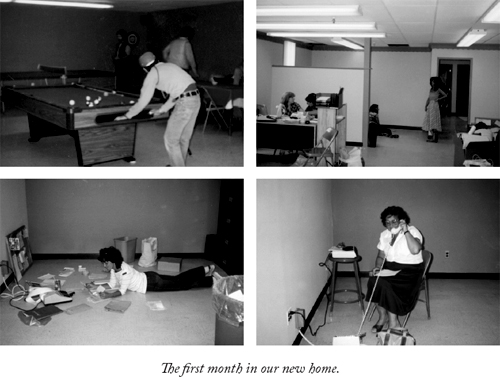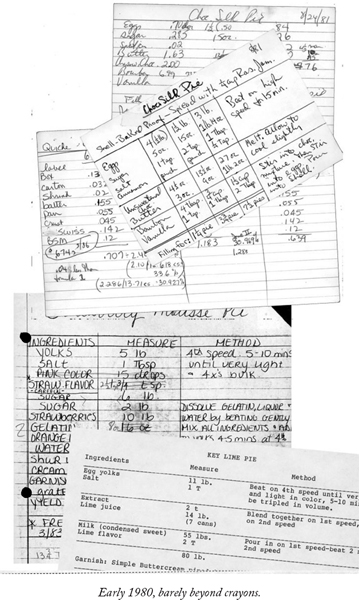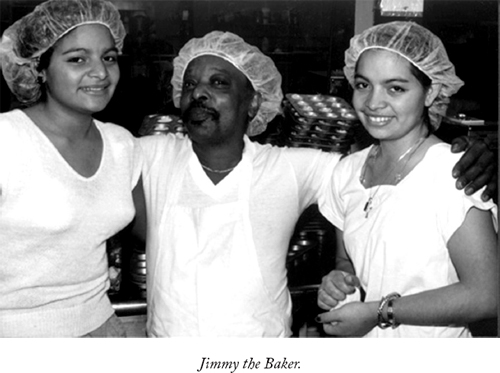With Love and Quiches (14 page)
Read With Love and Quiches Online
Authors: Susan Axelrod

After the tour, we stopped for lunch at the very first unit, complete with a “Welcome Susan and Irwin” sign! Much to my chagrin, they were serving alligator as an appetizer that day. Definitely not on my list, but I had to be polite and taste some.
So, we survived the move and increased overhead, the interest rates began to moderate, and we doubled our volume in the first two years in Freeport. We had reached just under $5 million yearly. We began to prosper.
Our office staff grew. We now had reps for customer service, accounts receivable, accounts payable, a warehouse manager, and our old-fashioned controller Mildred (who looked the part right out of central casting), as well as a small sales staff. We also contracted our first payroll service, ADP, and it was through them that we began our first simple foray into computerization, limited as it was to invoicing and rudimentary accounts receivable. Our accounts payable were still done by general ledger, as was our inventory, and there was nothing
yet
in the way of customer or product analysis. The early eighties and the computer age were still ahead of us.
We continued our growth into more restaurant chains and more distributors, and we further penetrated the airline industry. It was an exhilarating period, and for the time, I was breathing a bit easier.
Spreading Our Wings (1980–1989)
I believe in luck, but you have to go out and find it.
—Oscar de la Renta
W
hen we first moved into Freeport, our offices were still a study in catch-as-catch-can. The back of the house was equipped, all shiny and ready to go, but we still had no furniture in our offices. We sat all over the floor to do our work. The employee lounge had no tables and chairs for lunch breaks, but we
did
have a pool table and a ping-pong table, and there was always a game in progress. What we did have was in order, and we were ready to do business.
Today in the office at Freeport we still have a closet full of archives, and I recently discovered a treasure trove of information and examples of how we did things in the early eighties. What I suppose should be embarrassing is quite funny, in retrospect. The important thing is that the mistakes of our beginnings—which we were still making aplenty in Freeport—didn’t keep us from building more business.

Very few small companies were computerized back then, so the fact that we weren’t was normal. Nevertheless, I can’t fathom how our business operated in the early days of computerization in light of what we have at our disposal today. As I look back on the early to mid-eighties, I smile when I recall how our pricing was still done via a system of index cards and a calculator! We had a two-man team for this—a bright young employee, Molly, and me. It couldn’t possibly have been more rudimentary. Hopefully we
mostly
remembered to use the most current price paid for our ingredients. We used three percentages to determine the price of our labor, choosing which to use based on whether the work was “easy,” “medium,” or “hard”! Amazing, but the system worked for us until later in the decade. On top of this, we were still doing our price lists on the typewriter since we were still quite a few years away from spreadsheets.
Our first foray into computerization through the payroll company ADP had been off-site, dial-up, and
painfully
slow. Very little else was computerized, but we had one employee who basically functioned as a human computer. Billy had previously been one of our drivers and
part of the Motley Crew back in Oceanside, and he had begun to stand out as being extremely bright. He quietly took control of our finished inventory, participated in production planning, and took the lead in managing our drivers and trucks, assigning routes and other related responsibilities. He was able to accurately track
in his head
the exact inventory we held for each and every quiche or cake, even after we had hundreds of products in our line, and this still held true even after we became computerized. Billy was our computer brain. We would send purchase orders back to him, and he would then send all the trucks out with handwritten bills of lading, after which he would come into the office to let us know exactly what
did
ship. We would then—
after
the fact!—print the invoices. Laura—who started working for us while still in her teens and who’s remained for more than twenty years—recalls that everybody in the office was afraid of Billy and had to remember three things: (1) Billy was always right; (2) Never say no to Billy; and (3) Billy took his coffee with cream and sugar!
We did know enough by now to upgrade our point-of-sale material, which we used on sales calls, at trade shows, and in mailings. We started using professionals to photograph our products and had our simple two-sided sell sheets typeset and professionally printed on glossy paper. But our product lines were constantly evolving, so we ended up with racks full of product brochures that were obsolete before the ink even dried.
With our first real bookkeeper, we had moved from our shoebox to a general ledger, which was maintained by our next two controllers even into the nineties. And our recipes, which we had yet to call “formulas,” were still handwritten on the ubiquitous index cards. Once we moved to Freeport, we “upgraded” to loose-leaf paper as we finally started adding method instructions to the recipes. It was in the mid-eighties that we “graduated” to the typewriter for recipes! A few years later we would
finally
migrate to entering all our formulas, complete with subassemblies, into the computer. But even at that point the formulas were in a word processing file, which had to
then be reentered into our integrated software as we initiated batch control, raw and finished inventory control, formula management, accounts receivable and payable, and so on. Doing things the hard way was one of our specialties, but as the years passed, we got better.
Very
much better.

Through our ADP dial-up, we had been delivered from writing our invoices and statements by hand. Soon after, in 1982, we brought in our first general office manager, Dave, who had worked for our first airline distributor before joining Love and Quiches. He knew much more about computers than any of the rest of us did. At his prompting, we invested in our first in-house IBM server, which was truly monstrous and ended up being installed right in his office. But we were still keying in the purchase orders on two “dumb” terminals that could only communicate with the server and not each other. (This was before PCs became “smart” and could communicate with each other.) Still, it was much quicker, and it represented another step forward.
During his first years after coming on board, Dave purchased a software program, Cimpro, from a company called DataLogix, as well as another (smaller) server and two more “dumb” terminals from Unisys. Invoicing and accounts receivable was the first module of the software package to be put into use. Several years later, we brought in a new IBM-AIX server that was even smaller and a
lot smarter
than what we’d had up until then. We also started adding more terminals because we had more employees doing a lot more things.
All of our orders came in via the phone, so we did not yet have any real need for a fax machine. But on the rare occasion when we did, someone would have to go next door to send a fax! And most of our business was still local. Our customer service staff was armed with client information noted on—you guessed it—index cards! They would go through the cards—sorted Monday for Tuesday delivery, Tuesday for Wednesday delivery, and so on—to call each customer for their next day order. Theoretically, if an index card got lost, misplaced, or misfiled, we could lose the customer and not even know it!
We may have been a ramshackle operation in some respects in those days, but our key employees continued to produce top-drawer products. Jimmy’s reputation as a legend followed us into Freeport. In fact, on many occasions an ingredient or equipment supplier would
spend the night at the plant helping to incorporate a new ingredient or machine seamlessly into production. They would always comment in the morning that they had never seen anything quite like the way Jimmy orchestrated the night’s production, moving his people around without a single wasted motion or moment. One supplier even likened it to a magnificent ballet performance!
Jimmy eventually had well over a hundred production workers under him. At the start of each evening, Jimmy always said he was “going up the hill” and toward the end he was “going down the hill.” One thing’s for sure, if we were out of an ingredient, he needed to be told in advance; otherwise, Irwin and I would likely get a call at two in the morning! Jimmy didn’t take kindly to any sudden changes in his Love and Quiches ballet.

As the years went by and our business became more computerized, we had to handle Jimmy very delicately, “making an appointment” in order to corner him in the conference room to wheedle all the details of a particular recipe out of him. Sometimes his description “about a handful and a half” was as close as we could get him to nail down
a particular measurement, although his handfuls never varied; they were as reliable as a scale. He was extremely protective of what he thought of as
his
recipes and equally suspicious of them falling into the wrong hands. Occasionally he would leave an ingredient or two out; at these times we’d have to bypass him, getting the needed specs from his second-in-command, for inventory and pricing purposes. He finally did
get it
, and became more cooperative, but basically he was just Jimmy being Jimmy!
During this time, another member of our original Motley Crew began to stand out. One of our drivers, Tom, had also worked in inventory control and production alongside Billy. He was learning more and more about the operation of both the hardware and the software, and he asked for an opportunity to be our in-house IT technician. We sent him to school, and it turned out his computer skills were superb. Tom proved himself very quickly and would remain with us until 1998, when he landed a big job with the New York Jets. He remembers that our biggest challenge, among other big challenges, was keeping the inventory of ingredients. Billy would hand him the production list for the night, and Tom would enter it into the system. Each morning at six Tom would corner Jimmy the Baker to get a list of what had been made the night before. Then he’d sit with Bonnie, our buyer, trying to “back into” the materials that had been
used
so that she could reconcile materials
required
for future orders. Her “system” for keeping everything straight was to use sticky notes all over her desk—a step backward even from my pricing system of handwritten index cards.
As we put a few years in Freeport behind us, our general office manager and Tom helped us take some big steps forward, technologically speaking. We added other modules within Cimpro (in addition to accounts payable, formula management, batch control, inventory control already added), such as cash flow management and sales analysis, which allowed our processes to become much more integrated. DataLogix was sold several times, and support for the program became more and more remote, so most of the enhancements over the years
were accomplished either by our own IT people or other consultants. There was still plenty of handwriting and typewriting, though! And, as you might imagine, our old-fashioned controllers were very distrustful of computers at first, and they were reluctant to let go of their general ledgers. They worked with the “dual” systems, just in case, but as time passed, they—along with the rest of us—learned to trust our technology and slowly join the march with the rest of the world toward meaningful computer systemization.
